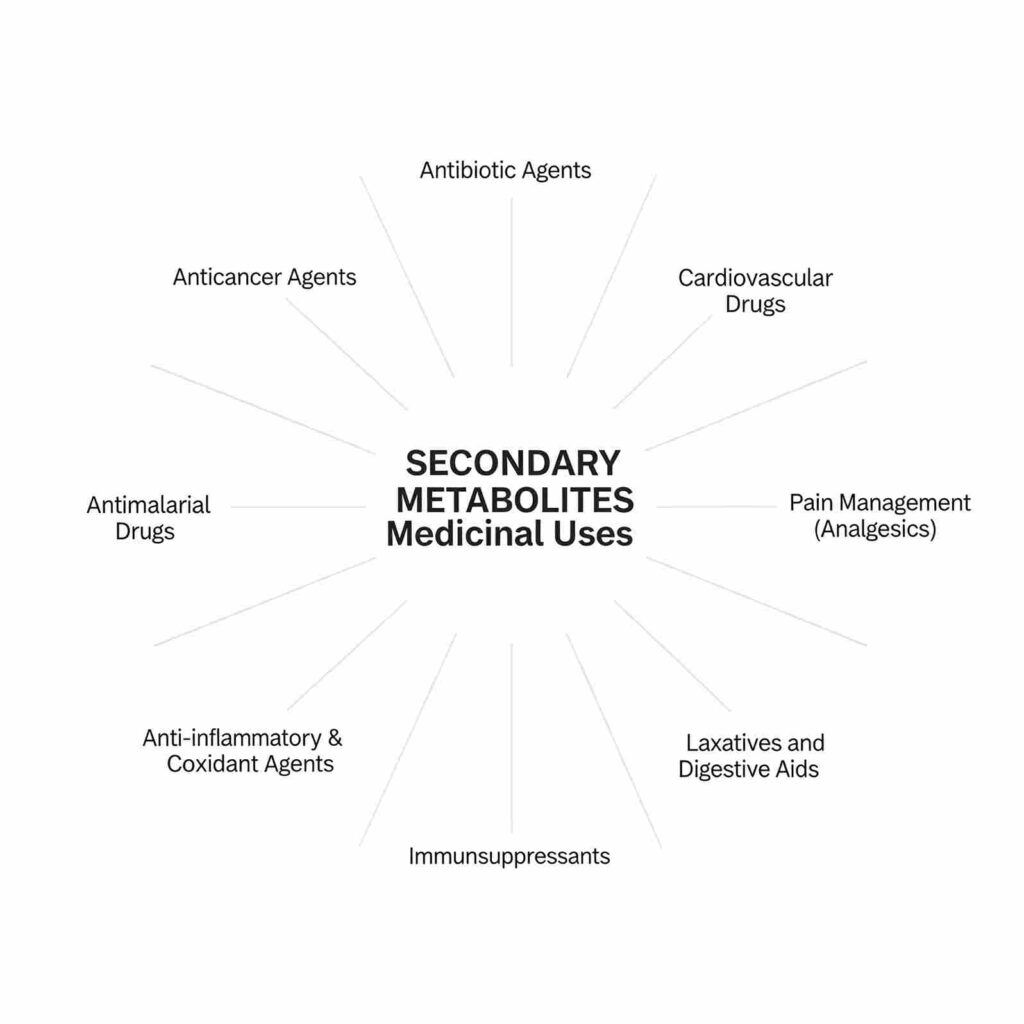Secondary metabolites are organic compounds produced by organisms (particularly plants, fungi, and microorganisms) that are not directly involved in their growth, development, or reproduction, but often provide ecological advantages. Many of these compounds have important medicinal applications due to their bioactive properties.
Types of secondary metabolites
Secondary metabolites can be divided into various types or categories based on pathways of synthesis or the class of secondary metabolite
Secondary metabolites can be divided into three category based on the major biological synthesis pathways –
- Terpanoids : Made from simple building blocks called isoprene units
- Phenolics : Compounds with a special chemical group called a “phenol ring.”
- Alkaloids : Nitrogen containing compouns
Applications of Secondary Metabolites
Secondary metabolites serve as a valuable source of novel drugs and therapeutic agents. Many modern pharmaceuticals are either directly derived from natural secondary metabolites or are synthetically modified versions. Their continued study is essential for the discovery of new medications, especially as resistance to existing drugs rises.

1. Secondary metabolite as Antibiotics
Various secondary metabolites like penicillin, tetracycline etc are a major source of antibiotics used to treat bacterial infections.
| Compound | Source Organism | Use |
| Penicillin | Penicillium spp. | Broad-spectrum antibiotic |
| Erythromycin | Streptomyces erythraeus | Antibiotic (respiratory infections) |
| Tetracycline | Streptomyces spp. | Broad-spectrum antibiotic |
2. as Anticancer
Some secondary metabolites are potent anticancer drugs used in chemotherapy.e.g.
| Compound | Source Plant | Use |
| Vincristine, Vinblastine | Catharanthus roseus | Treatment of leukemia, lymphoma |
| Taxol (Paclitaxel) | Taxus brevifolia (Pacific yew) | Breast, ovarian, and lung cancers |
| Camptothecin | Camptotheca acuminata | Chemotherapy drug precursor |
3. Cardiovascular Drugs
Certain secondary metabolites affect heart function and are used in cardiac therapy.
| Compound | Source Plant | Use |
| Digoxin, Digitoxin | Digitalis purpurea (foxglove) | Treatment of heart failure, arrhythmias |
| Resveratrol | Grapes, berries | Cardioprotective, antioxidant |
4. Antimalarial Drugs
These compounds are used to treat or prevent malaria.
| Compound | Source Plant | Use |
| Quinine | Cinchona spp. | Antimalarial |
| Artemisinin | Artemisia annua | Highly effective antimalarial |
5. Pain Management (Analgesics)
Some secondary metabolites have powerful pain-relieving properties. e.g. Morphine, Codeine, isolated from Papaver somniferum (opium poppy)
6. Laxatives and Digestive Aids
Used to relieve constipation or improve digestion. E.g. Sennosides, Aloin from senna spp. And aloe vera respectively.
7. Immunosuppressants
Used to prevent organ transplant rejection and treat autoimmune diseases. Immunosuppressants are drugs that weaken or suppress the immune system’s activity. Cyclosporine A from Tolypocladium inflatum is one of such secondary metabolite with immunosuppressants
8. Anti-inflammatory & Antioxidant Agents
inflammation is a natural defense, chronic or excessive inflammation can cause pain, swelling, and tissue damage. Various secondary metabolites help in reducing inflammation and oxidative stress. For example Curcumin from curcuma longa (turmeric) and Resveratrol ( from grapes, berries).
| Pharmaceutical Use | Class of Secondary Metabolite | Metabolite Source |
| Analgesic (pain relief) | Alkaloids | Morphine (from Papaver somniferum) |
| Antimalarial | Quinine (from Cinchona bark) | |
| Anti-cancer (chemotherapy) | Vincristine & Vinblastine (Catharanthus roseus) | |
| Antimalarial | Terpenoids (Terpenes) | Artemisinin (from Artemisia annua) |
| Anti-cancer (breast, ovarian cancers) | Taxol (from Taxus brevifolia) | |
| Antioxidant, cardioprotective | Phenolics | Resveratrol (from grapes) |
| Anti-inflammatory, anticancer potential | Curcumin (from turmeric) | |
| Treatment of heart failure and arrhythmia | Glycosides | Digoxin (from Digitalis species) |
| Laxative | Sennosides (from Senna species) | |
| Antibiotic | Polyketides | Erythromycin (from Streptomyces) |
| Broad-spectrum antibiotic | Tetracycline | |
| Immunosuppressant (organ transplant) | Non-ribosomal peptides | Cyclosporin A |
References
- erythromycin, https://www.britannica.com/science/erythromycin, access on 12/09/2025
- https://extractionmagazine.com/2023/07/16/extraction-and-isolation-of-morphine-from-papaver-somniferum-l/ , accessed on 12/09/2025
- Singh CK, Liu X, Ahmad N. Resveratrol, in its natural combination in whole grape, for health promotion and disease management. Ann N Y Acad Sci. 2015 Aug;1348(1):150-60. doi: 10.1111/nyas.12798. Epub 2015 Jun 22. PMID: 26099945; PMCID: PMC4553113.
- Lee HY, Kim SW, Lee GH, Choi MK, Jung HW, Kim YJ, Kwon HJ, Chae HJ. Turmeric extract and its active compound, curcumin, protect against chronic CCl4-induced liver damage by enhancing antioxidation. BMC Complement Altern Med. 2016 Aug 26;16(1):316. doi: 10.1186/s12906-016-1307-6. PMID: 27561811; PMCID: PMC5000414.
- Khandelwal R, Vagha JD, Meshram RJ, Patel A. A Comprehensive Review on Unveiling the Journey of Digoxin: Past, Present, and Future Perspectives. Cureus. 2024 Mar 23;16(3):e56755. doi: 10.7759/cureus.56755. PMID: 38650769; PMCID: PMC11033962.
